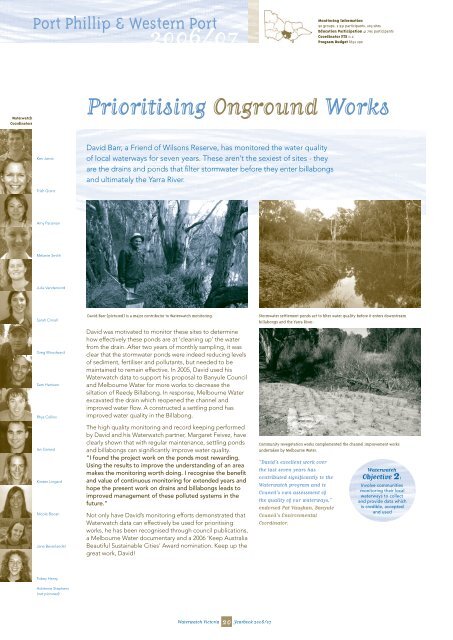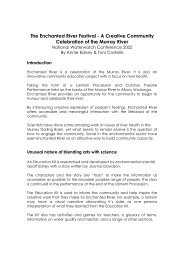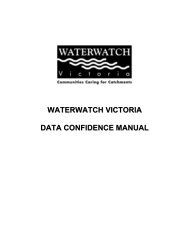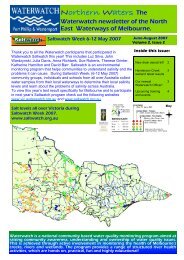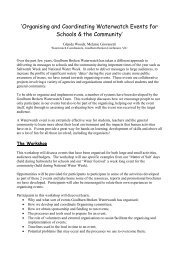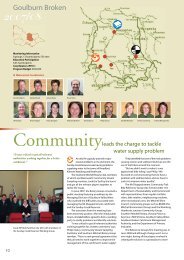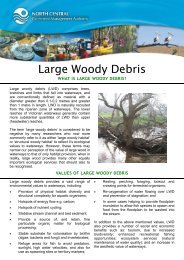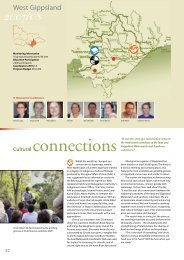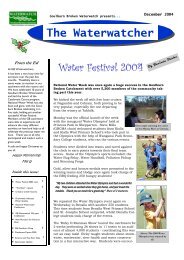Port Phillip - Waterwatch Victoria
Port Phillip - Waterwatch Victoria
Port Phillip - Waterwatch Victoria
You also want an ePaper? Increase the reach of your titles
YUMPU automatically turns print PDFs into web optimized ePapers that Google loves.
<strong>Port</strong> <strong>Phillip</strong> & Western <strong>Port</strong><br />
2006/07<br />
Monitoring Information<br />
90 groups, 2 931 participants, 203 sites<br />
Education Participation 41 795 participants<br />
Coordinator FTE 11.2<br />
Program Budget $652 290<br />
<strong>Waterwatch</strong><br />
Coordinators<br />
Prioritising Onground Works<br />
Keir Jarvis<br />
David Barr, a Friend of Wilsons Reserve, has monitored the water quality<br />
of local waterways for seven years. These aren’t the sexiest of sites - they<br />
are the drains and ponds that filter stormwater before they enter billabongs<br />
and ultimately the Yarra River.<br />
Trish Grant<br />
Amy Paraman<br />
Melanie Smith<br />
Julia Vanderoord<br />
Sarah Crinall<br />
Greg Woodward<br />
Sam Harrison<br />
Rhys Collins<br />
Ian Garsed<br />
Kirsten Lingard<br />
Nicole Biscan<br />
Jane Beverlander<br />
David Barr (pictured) is a major contributor to <strong>Waterwatch</strong> monitoring.<br />
David was motivated to monitor these sites to determine<br />
how effectively these ponds are at ‘cleaning up’ the water<br />
from the drain. After two years of monthly sampling, it was<br />
clear that the stormwater ponds were indeed reducing levels<br />
of sediment, fertiliser and pollutants, but needed to be<br />
maintained to remain effective. In 2005, David used his<br />
<strong>Waterwatch</strong> data to support his proposal to Banyule Council<br />
and Melbourne Water for more works to decrease the<br />
siltation of Reedy Billabong. In response, Melbourne Water<br />
excavated the drain which reopened the channel and<br />
improved water flow. A constructed a settling pond has<br />
improved water quality in the Billabong.<br />
The high quality monitoring and record keeping performed<br />
by David and his <strong>Waterwatch</strong> partner, Margaret Feivez, have<br />
clearly shown that with regular maintenance, settling ponds<br />
and billabongs can significantly improve water quality.<br />
“I found the project work on the ponds most rewarding.<br />
Using the results to improve the understanding of an area<br />
makes the monitoring worth doing. I recognise the benefit<br />
and value of continuous monitoring for extended years and<br />
hope the present work on drains and billabongs leads to<br />
improved management of these polluted systems in the<br />
future.”<br />
Not only have David’s monitoring efforts demonstrated that<br />
<strong>Waterwatch</strong> data can effectively be used for prioritising<br />
works, he has been recognised through council publications,<br />
a Melbourne Water documentary and a 2006 ‘Keep Australia<br />
Beautiful Sustainable Cities’ Award nomination. Keep up the<br />
great work, David!<br />
Stormwater settlement ponds act to filter water quality before it enters downstream<br />
billabongs and the Yarra River.<br />
Community revegetation works complemented the channel improvement works<br />
undertaken by Melbourne Water.<br />
“David’s excellent work over<br />
the last seven years has<br />
contributed significantly to the<br />
<strong>Waterwatch</strong> program and to<br />
Council’s own assessment of<br />
the quality of our waterways,”<br />
endorsed Pat Vaughan, Banyule<br />
Council’s Environmental<br />
Coordinator.<br />
<strong>Waterwatch</strong><br />
Objective 2:<br />
Involve communities<br />
monitoring their local<br />
waterways to collect<br />
and provide data which<br />
is credible, accepted<br />
and used<br />
Tobey Henry<br />
Adrienne Stephens<br />
(not pictured)<br />
<strong>Waterwatch</strong> <strong>Victoria</strong> 20 Yearbook 2006/07
Two neighbouring community<br />
groups - First Friends of<br />
Dandenong Creek (FFDC)<br />
and Knox Environment Society<br />
(KES) – know their local waterways<br />
intimately, having monitored 11<br />
sites monthly for 7 years. That is<br />
almost 55 working days spent on<br />
monitoring! Two men, Barry<br />
Robinson from FFDC and Graeme<br />
Patterson from KES, are especially<br />
dedicated to their local environment<br />
and to sharing their knowledge<br />
and expertise with their local<br />
community. Its people like Barry<br />
and Graeme that you find at the<br />
heart of <strong>Waterwatch</strong>’s achievements.<br />
<strong>Waterwatch</strong><br />
Objective 1:<br />
Increase community<br />
awareness, understanding<br />
and ownership of water<br />
issues and their relationship<br />
to catchment health<br />
Woori Yallock kids join <strong>Waterwatch</strong> Coordinator Trish Grant to learn more about their local waterway.<br />
In 2006, Greening Australia <strong>Victoria</strong> partnered with <strong>Waterwatch</strong> to<br />
deliver a schools programme along the Yarra River, sponsored by<br />
Melbourne Water. Children from the Woori Yallock area helped out at<br />
one local site by planting trees, checking on water quality in creeks, and by<br />
learning more about indigenous history and cultural values of the area.<br />
These events focussed attention on creek erosion and provided handson<br />
action to improve local waterways for people, plants and animals in and<br />
around them.<br />
<strong>Waterwatch</strong><br />
Objective 3:<br />
Increase community<br />
involvement in water<br />
management decisions and<br />
gain community commitment<br />
to action in addressing<br />
waterway and catchment<br />
issues<br />
Students from St Macartan’s Primary School<br />
represent their environmental learnings through<br />
artwork.<br />
For the second year running<br />
<strong>Waterwatch</strong> was a part of<br />
the Level 3 (Grade 3 and 4)<br />
curriculum at St Macartan’s Primary<br />
School, Mornington. The ‘Feathers,<br />
Fur and Fins’ integrated unit ran<br />
for eight weeks with the central<br />
focus question ‘In what ways do<br />
humans influence the survival of<br />
animals?’. Students learned to<br />
recognise local frog calls and<br />
investigated macro-invertebrate<br />
sensitivities before spending the<br />
day at local Tanti Creek. Scientific<br />
maps cooperatively drawn by<br />
class groups were the result of the<br />
<strong>Waterwatch</strong> investigations.<br />
<strong>Waterwatch</strong><br />
Objective 5:<br />
Sunshine Middle Years<br />
Learning Environment<br />
(SMYLE) school cluster have<br />
been working in partnership with<br />
Maribyrnong <strong>Waterwatch</strong> and<br />
Brimbank City Council to document<br />
the habitat and stream conditions<br />
of Kororoit Creek from its source<br />
to <strong>Port</strong> <strong>Phillip</strong> Bay. A two-day bus<br />
tour with Brimbank Council and<br />
<strong>Waterwatch</strong> staff along the length<br />
of the creek highlighted a number<br />
of issues affecting their local<br />
waterway, including recent housing<br />
developments and historical land<br />
uses. Students have presented<br />
their findings and recommendations<br />
at local environment forums.<br />
4<br />
2<br />
5<br />
1<br />
3<br />
Provide school learning<br />
opportunities and be an<br />
integral part of the<br />
curriculum<br />
Other outstanding highlights and<br />
achievements<br />
Greg Woodward – Melbourne Award<br />
nominee (Contribution to Environment)<br />
<strong>Waterwatch</strong>ing Edwardes Lake<br />
Neighbourhood Environment<br />
Improvement Plan – winner of 2007<br />
Keep Australia Beautiful Sustainable<br />
Cities Award (Community-Government<br />
partnership category)<br />
<strong>Waterwatch</strong>er Gill Gordon – winner of<br />
2006 Keep Australia Beautiful Dame<br />
Phyllis Frost Award<br />
A majestic remnant red gum alongside Kororoit Creek.<br />
<strong>Waterwatch</strong> Coordinator Rhys Collins joins teachers<br />
to scope study sites along Kororoit Creek.<br />
<strong>Waterwatch</strong> <strong>Victoria</strong> 21 Yearbook 2006/07<br />
<strong>Waterwatch</strong><br />
Objective 4:<br />
Establish and maintain<br />
effective partnerships<br />
between the community<br />
and catchment<br />
managers<br />
Partners/Sponsors Melbourne Water, Natural Heritage<br />
Trust, Department of Sustainability & Environment,<br />
Department of Primary Industries, Merri Creek<br />
Management Committee, Banyule City Council, Baw Baw<br />
Shire Council, Boroondara City Council, Brimbank City<br />
Council, Cardinia Shire Council, Casey City Council,<br />
Darebin City Council, Frankston City Council, Greater<br />
Dandenong City Council, Hobsons Bay City Council,<br />
Hume City Council, Kingston City Council, Knox City<br />
Council, Manningham City Council, Maribyrnong City<br />
Council, Maroondah City Council, Melbourne City<br />
Council, Melton City Council, Monash City Council,<br />
Moonee Valley City Council, Moorabool Shire Council,<br />
Moreland City Council, Mornington Peninsula Shire<br />
Council, Nillumbik Shire Council, Stonnington City<br />
Council, Whitehorse City Council, Whittlesea City<br />
Council, Wyndham City Council, Yarra City Council,<br />
Yarra Ranges, Nestle, <strong>Port</strong> <strong>Phillip</strong> & Western <strong>Port</strong><br />
Catchment Management Authority.<br />
Photos courtesy of <strong>Port</strong> <strong>Phillip</strong> and Western<br />
<strong>Port</strong> <strong>Waterwatch</strong>.


